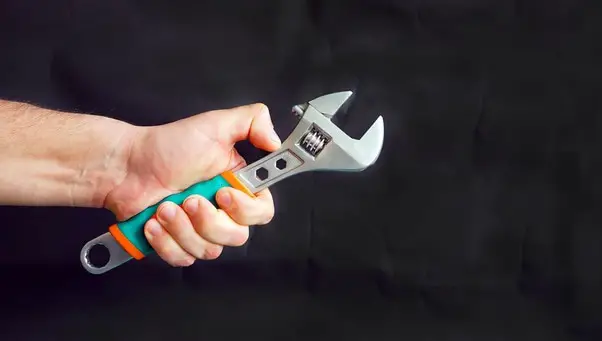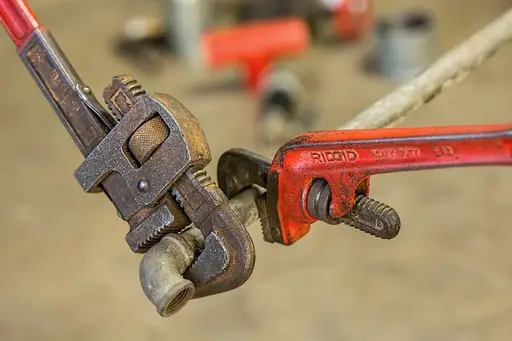You know how handy a wrench is if you have had to tighten or loosen some nuts or bolts. However, with so many types of wrenches, it can be difficult to choose the right one. This article will demystify the different types of adjustable wrenches.
18 Adjustable Wrench Types
1. Crescent Wrench
These are the most common type of adjustable wrenches. They are a do-it-all type of wrench as they can be used with basically any type of bolts or nuts. They also have a wide range of applications, including woodwork, plumbing, DIY projects, and automotive repair.
A crescent wrench is double-sided. It has one adjustable end while the other is fixed. The adjustable end has a turning dial that allows you to open and close the wrench jaw for a perfect fit on the nuts and bolts you will be using it on.
The crescent wrench comes in various sizes ranging from four inches up to four feet. The most common ones are about 4-12 inches long.
2. Pipe Wrench

As the name suggests, a pipe wrench is a type of adjustable wrench mainly used for tightening or loosening pipes. They have a wider jaw opening than crescent wrenches.
Pipe wrenches have a slightly angled jaw, which provides a firm grip on the pipe without damaging it. They have adequate handle length for easy handling. When you clasp a pipe wrench on a pipe, the angled jaw with teeth holds the pipe firmly, giving you leverage to turn the pipe either clockwise or counterclockwise.
Pipe wrenches are available in a broad range of sizes. Small, 8-inch wrenches can be used on ¼- ¾ pipes, while 24-inch wrenches are suitable for 1-2 inch pipes. Larger 48-inch pipe wrenches can handle pipes of up to 5-inch diameter.
3. Self-Adjusting Pipe Wrench
This is a sophisticated type of adjustable pipe wrench. It is fitted with a spring that makes adjusting the jaw size quicker and more convenient. You can easily adjust it using one hand. They come in a limited range of sizes, usually ranging from 8-12 inches on the smaller spectrum. As such, they are suitable for 5/8 – 1 ½ pipe diameter.
4. Multi-Angle Pipe Wrench
A multi-angle pipe wrench has an adjustable head angle. It is best suited for loosening and tightening pipes in tight corners. It works similarly to a regular pipe wrench, other than the angled head. Its jaw has teeth, and it has a dial for adjusting the jaw opening. Typically, they are available in sizes 8-12 inches.
5. Swedish Pipe Wrench
This is yet another type of adjustable pipe wrench. It has a similar look as vice grip pliers. They are designed to slide the bottom part of the handle up to tighten the jaws. They have a lock-in place mechanism that ensures that the wrench has a firm grip on the pipe. Since their adjustment mechanism requires both hands, they are not suitable for use in tight places.
They are versatile and can be used for automotive work such as loosening tie rods. Most are 10-16 inches long and are suitable for use with pipes less than 2 inches in diameter.
6. Basin Wrench
Plumbers mainly use a basin wrench to loosen or tighten drains, faucet nuts, and supply lines. They are considerably long, 12-12 inches, and the head is relatively small. Therefore, you do not have to crawl under cabinets and other tight spaces. Some have a telescopic handle for ease and convenience in adjusting the handle.
7. Chain Wrench
A chain wrench has a chain that is attached to the head. The chain wraps around the object and then locks in place for a firm grip. You then leverage the handle to tighten or loosen the object. Since the handle is metallic and heavy, you should not use this type of adjustable wrench on fragile objects. Generally, their size is measured depending on the length of the chain. Most have chains that are 12-24 inches long.
8. Strap Wrench
They are a do-it-all type of wrench as they can be used on most objects. Their design constitutes an adjustable rubber or cloth strap. You can shorten or tighten the strap as needful for a firm grip on the object. The strap size ranges between 6 inches to 3 feet.
9. Monkey Wrench
The monkey wrench, also known as the adjustable spanner, looks a lot like pipe wrenches, except that their handles are more streamlined to enable them to fit in tight spaces. They also have an angled jaw. They are mostly used for automotive work; they are often referred to as sliding automotive wrenches.
An adjustable spanner is not suitable for use on pipes as their jaw is made of hardened metal, which may cause damage to the pipes. Therefore, they are best for working on bolts and nuts. Most range between 8-18 inches in length, while the industrial version is up to four feet long.
10. Lock Nut Wrench
A lock nut edge is exclusively designed for loosening or tightening nuts on the strainer basket under the sink. The jaw is spring-loaded for easy adjustment. They have a standard size of 12-inches and are best suited for use with ¾” or ½” nuts.
11. Hex Wrench
A hex wrench looks like a pipe wrench, but it has a hex-shaped and angled head. They are suitable for working on drain nuts on sinks and tubs. Most are 8-12 inches long, although you can get longer ones. The standard 10-inch hex wrench can be used on 1 – 2 ½ inch wrenches.
12. Plumber’s Wrench
A plumber’s wrench is also known as an adjustable slip-nut wrench. It has a similar design to a crescent wrench but differs in that its jaws are straight while those of a crescent wrench are angled.
One side of the jaw is fixed while the other is adjustable. They have a locking nut that keeps the jaw in place. Plumber’s wrenches are best suited for slip nuts, locknuts, basket strainer nuts, and spud nuts. They are available in limited size options compared to crescent wrenches. Their jaws usually open 1-3 inches.
13. Spud Wrench
A spud wrench has a tapered spike at the end of the handle to align bolts when installing different automotive components, beams, or pipe fittings. The other end of a spud wrench can be used to rotate fasteners during installation or removal.
14. Combination Wrench
A combination wrench is simply an adjustable wrench designed with one open end and one socket end. The combination wrench is often used to unfasten nuts and bolts with the box end and quickly separate them with the open end.
15. Adjustable Socket Wrench
The socket wrench is also known as a socket spanner and uses a closed socket format instead of the usual open wrench to turn a fastener. It allows you to turn nuts and bolts without repositioning your tool on the fastener.
16. Adjustable Torque Wrench
A torque wrench is a hand tool used to adjust nuts and bolts. With a torque wrench, you can apply a specific amount of torque to your fasteners. It never hurts to double-check your work when using a torque wrench. You want to make sure you apply the right amount of torque each time.
17. Impact Wrench
The impact wrench stands apart from the rest of these hand tools because this wrench type is considered a power tool. It can deliver a high level of torque output with just minimal exertion. An impact wrench is the tool used most often to tighten and untighten bolts and is often used in mechanical and industrial applications. It is possible to adjust an impact wrench, but it isn’t always easy.
18. Crowfoot Wrench
A crowfoot wrench allows for tighter clearance of offset sockets. It is an open end wrench type that doesn’t have a handle or shaft. This kind of wrench can easily access fasteners from the tops and sides of tighter spaces where you can’t use a more traditional open end wrench.
Factors to Consider When Buying the Best Adjustable Wrench

Adjustable Wrench Size
The size of the best adjustable wrench is determined in two ways – it is determined according to the size of the objects they can be used on and the length of the handle. Since the jaw size is adjustable, most manufacturers provide the objects’ minimum and maximum diameter.
With that said, the length of the handle is the standard sizing criteria. Therefore, a 12-inch adjustable wrench is 12-inches long.
When determining which is the right size wrench to use, consider the diameter of the object you will be using it on and the handle length that is the most suitable.
Price
Adjustable wrenches are generally affordable, starting at less than 10 dollars to about $25. You can also buy sets of different sizes of wrenches or different types of wrenches affordably. Ensure to check reviews to ascertain that they are of high quality and work efficiently.
Purpose
Some adjustable wrenches are considered do-it-all wrenches and can be used for different objects, while others are designed for specific applications, such as pipe wrenches for use on pipes and lock-nut wrenches for nuts.
Durability
Whether you are a professional or a DIYer, your adjustable wrench must be durable, especially if you intend to use it many times and over a long period. The key factor to look for when determining durability is the material used to make the wrench.
Steel is most preferable as it is sturdy. Since steel is prone to rust, go for a wrench with a rust-resistant coating. For instance, nickel or chrome plated wrenches offer excellent rust resistance.
Also, opt for wrenches backed with a warranty or satisfaction guarantee. It indicates the manufacturer’s confidence in their products, and you can return it in case the wrench does not meet your expectations.
Tips for Using Adjustable Wrenches
- Apply minimal pressure when adjusting the jaw as too much pressure may damage the object
- It is best to use two hands for extra support and easier handling unless operating in tight spaces
- Ensure that the jaw is well clasped on the object and has a firm grip before attempting to loosen or tighten the object
- Clean your wrenches after use by wiping them off with a rag and store in a cool, dry place
- If your wrench is worn out, broken, or rusted, throw it away and replace it with a new one. Such wrenches increase the risk of injury when using them and may cause damage to the objects
Conclusion
Whether you are working on pipes, nuts, tie rods, bolts, oil filters, or any other objects that require tightening or loosening, you will need a wrench for the job. Choose one that is suited for the type and size of the object. Also, consider if you will be working on tight spaces and choose accordingly.

